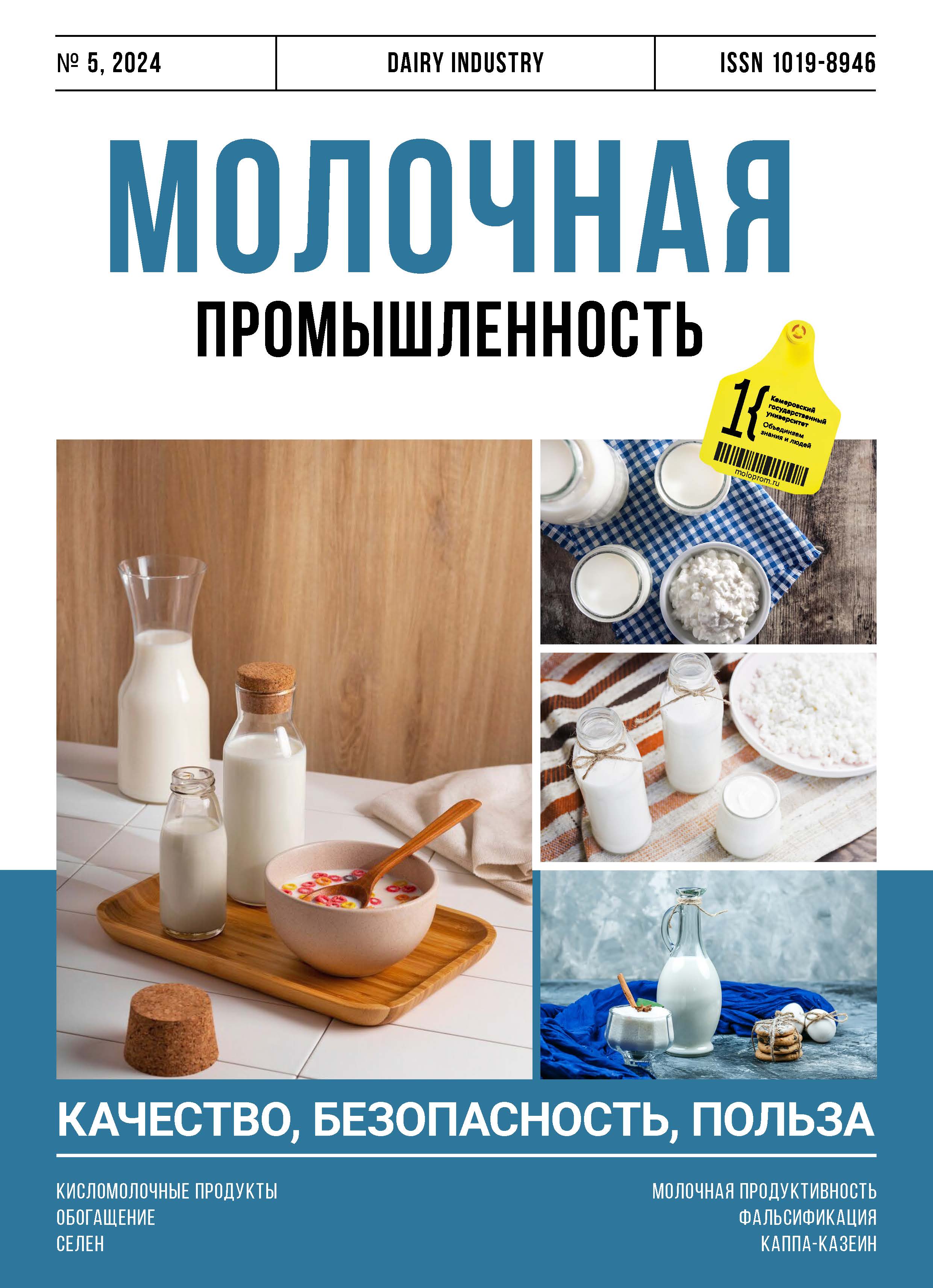Maisky, Russian Federation
Maisky, Russian Federation
Maisky, Russian Federation
Maisky, Russian Federation
Gastrointestinal infectious diseases accompany the growth of animal and poultry farming: as the livestock population increases, its high concentration on farms raises the level of mortality and rejection, thus reducing the overall safety and productivity. Probiotics and prebiotics used as feed additives may be an effective preventive measure. The article describes a sustainable and environmentally friendly method for obtaining prebiotics of pectin oligosaccharides by hydrolyzing apple pomace pectin in whey with Saccharomyces cerevisiae to produce bifidogenic animal feed. The 5:1 ratio of whey and apple pomace increased the yeast biomass by 56.3% after 24 h of fermentation and introducing 0.3% yeast by weight. The pectin hydrolysis products triggered an intensive growth of the substrate. The hydrolysis products contained 32% oligosaccharides of average molecular weight. The enzymatic hydrolysis of whey-apple mixes with a β-galactosidase preparation by deep cultivation of Bacillus licheniformis prevented the negative effect of serum lactose consumption, as well as increased the yield of yeast biomass. The optimal hydrolysis parameters were pH 6.0, 25 °C, 0.04% enzyme, and 6 h. The technological process included the following stages. The raw materials were prepared as a whey-vegetable mix (5:1), which was gradually heated to 65 °C. After cooling down to 22-25 °C, dry Saccharomyces cerevisiae provided fermentation and deoxidation. After introducing lactase enzyme and final thermal treatment, the finished feed additive contained 10% solids, 3.5% nitrogenous substances, 0.6% pectin, 0.3% pectin oligosaccharides, and 0.2% residual lactose, as well as vitamins and minerals.
feed additive, prebiotics, pectin oligosaccharides, yeast Saccharomyces cerevisiae, β-galactosidase, whey, apple pomace, secondary raw materials
1. Ji, Z. Identification of mare milk adulteration with cow milk by liquid chromatography-high resolution mass spectrometry based on proteomics and metabolomics approaches / Z. Ji [et al.] // Food Chemistry. 2023.Vol. 405, part B. 134901. https://doi.org/10.1016/j.foodchem.2022.134901
2. Lyubimova, Yu. G. Zhirnye kisloty kobyl'ego moloka i ih znachenie v pitanii cheloveka (analiticheskiy obzor) / Yu. G. Lyubimova, V. A. Tereschenko, E. A. Ivanov // Politematicheskiy setevoy elektronnyy nauchnyy zhurnal Kubanskogo gosudarstvennogo agrarnogo universiteta. 2020. № 164. S. 330–338. https://doi.org/10.21515/1990-4665-164-027; https://www.elibrary.ru/bxtyhu
3. Simonenko, E. S. Perspektivy ispol'zovaniya kobyl'ego moloka dlya sozdaniya produktov dieticheskogo lechebnogo i dieticheskogo profilakticheskogo pitaniya / E. S. Simonenko, S. V. Simonenko, Yu. S. Hovanova // Mezhdunarodnyy nauchno-issledovatel'skiy zhurnal. 2021. № 12-1(114). S. 157–161. https://doi.org/10.23670/IRJ.2021.114.12.026; https://www.elibrary.ru/sqwkri
4. Cais-Sokolińska, D. Foaming and Other Functional Properties of Freeze-Dried Mare’s Milk / D. Cais-Sokolińska, J. Teichert, J. Gawałek // Foods. 2023. Vol. 12(11). 2274. https://doi.org/10.3390/foods12112274
5. Krivova, A. V. Aromaticheskie aminokisloty: fenilalanin i tirozin u pacientov s arterial'noy gipertenziey i ishemicheskoy bolezn'yu serdca / A. V. Krivova, M. V. Kozhevnikova, E. O. Korobkova [i dr.] // Racional'naya farmakoterapiya v kardiologii. 2022. T. 18, № 3. S. 297–305. https://doi.org/10.20996/1819-6446-2022-06-05; https://www.elibrary.ru/rbctpl
6. Lysikov, Yu. A. Aminokisloty v pitanii cheloveka / Yu. A. Lysikov // Eksperimental'naya i klinicheskaya gastroenterologiya. 2012. № 2. S. 88–105. https://www.elibrary.ru/tbjprx
7. Orazov, A. Ocenka biologicheskoy cennosti moloka sel'skohozyaystvennyh zhivotnyh / A. Orazov, L. A. Nadtochiy, A. V. Safronova // Tehnika i tehnologiya pischevyh proizvodstv. 2019. T. 49, № 3. S. 447–453. https://doi.org/10.21603/2074-9414-2019-3-447-453; https://www.elibrary.ru/zygldg
8. Masharipova, Sh. S. Kumysolechenie oslablennyh detey v Horezmskom regione / Sh. S. Masharipova, A. U. Matyakubova // Nauka, obrazovanie i kul'tura. 2020. № 2(46). S. 49–51. https://doi.org/10.24411/2413-7111-2020-10201; https://www.elibrary.ru/nmexia
9. Manuylov, B. M. Perspektivnye specializirovannye produkty detskogo pitaniya / B. M. Manuylov, S. V. Simonenko // Mezhdunarodnyy nauchno-issledovatel'skiy zhurnal. 2020. № 11-1(101). S. 111–117. https://doi.org/10.23670/IRJ.2020.101.11.018; https://www.elibrary.ru/ydhhgb
10. Stepanov, K. M. Ispol'zovanie kobyl'ego moloka dlya sozdaniya specializirovannoy pischevoy produkcii / K. M. Stepanov, E. I. Semenova, L. D. Olesova, O. G. Tihonova // Mezhdunarodnyy nauchno-issledovatel'skiy zhurnal. – 2020. № 12-2(102). S. 146–149. https://doi.org/10.23670/IRJ.2020.102.12.062; https://www.elibrary.ru/hrpkmy
11. Saukenova, M. M. Ocenka pischevoy cennosti i ekologicheskoy bezopasnosti kobyl'ego moloka i kumysa / M. M. Saukenova, B. M. Nurgalieva, G. E. Rysmuhambetova, M. V. Zabelina // Novye tehnologii. 2022. T. 18, № 1. S. 62–70. https://doi.org/10.47370/2072-0920-2022-18-1-62-70; https://www.elibrary.ru/xnduoc
12. Sarsembaev, H. S. Kombinirovannyy kislomolochnyy produkt dlya sportivnogo pitaniya / H. S. Sarsembaev, Yu. A. Sinyavskiy, E. A. Deripaskina [i dr.] // Chelovek. Sport. Medicina. 2022. T. 22, № 1. S. 148–154. https://doi.org/10.14529/hsm220120; https://www.elibrary.ru/ittkab
13. Kanareykina, S. G. Zhirnokislotnyy sostav yogurta s ispol'zovaniem kobyl'ego moloka / S. G. Kanareykina, V. I. Kanareykin, Yu. N. Chernyshenko, I. F. Rahmatullina // Vestnik MGTU. Trudy Murmanskogo gosudarstvennogo tehnicheskogo universiteta. 2021. T. 24, № 4. S. 408–413. https://doi.org/10.21443/1560-9278-2021-24-4-408-413; https://www.elibrary.ru/dbvqpl
14. Abdulzhanova, M. A. Poluchenie yogurta na osnove suhogo kobyl'ego moloka, obogaschennogo probioticheskimi mikrokapsulami / M. A. Abdulzhanova, A. S. Kistaubaeva, L. V. Ignatova [i dr.] // Mikrobiologiya zhәne virusologiya. 2023. T. 2, № 41. S. 96–116. https://doi.org/10.53729/MV-AS.2023.02.06
15. Saukenova, M. M. Razrabotka receptury morozhenogo s ispol'zovaniem kobyl'ego moloka i polisaharidov / M. M. Saukenova, B. M. Nurgalieva, K. E. Beloglazova [i dr.] // Vestnik MGTU. Trudy Murmanskogo gosudarstvennogo tehnicheskogo universiteta. 2023. T. 26, № 3. S. 281–291. https://doi.org/10.21443/1560-9278-2023-26-3-281-291; https://www.elibrary.ru/bbilgg
16. Simonenko, E. S. Issledovanie hranimoustoychivosti i opredelenie strukturno-mehanicheskih pokazateley probioticheskogo kislomolochnogo produkta na osnove kobyl'ego moloka / E. S. Simonenko // Mezhdunarodnyy nauchno-issledovatel'skiy zhurnal. 2022. T. 116, № 2. S. 163–168.
17. Cais-Sokolińska, D. Freezing point and other technological properties of milk of the Polish Coldblood horse breed / D. Cais-Sokolińska [et al.] // Journal of Dairy Science. 2018. Vol. 101, Iss. 11. P. 9637–9646. https://doi.org/10.3168/jds.2018-15012
18. Potočnik, K. Mare's milk: composition and protein fraction in comparison with different milk species / K. Potočnik [et al.] // Mljekarstvo. 2011. Vol. 61(2). P. 107–113.
19. Adil, S. Chemistry, Nutritional Properties and Application of Mare’s Milk: A Review / S. Adil, B. M. Mehta, A. H. Jana // Agricultural Reviews. 2022. Vol. 43 (3). P. 355–361. https://doi.org/10.18805/ag.R-2232






